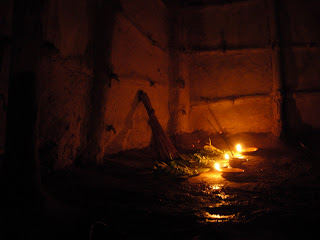
The festival of Dasain, (Dashiya in Tharu), one of the two biggest Hindu festivals, was celebrated in October this year. The name means ‘tenth’ – the festival lasts for 10 days.
In Tharu families, the eldest son is responsible for looking after the family gods and worshipping them during the Dashain festival. On the first day, Ghatasthapana, Tharus pray to the moon, saying ‘Ditiya ditiya ram ram’. Maize seeds are planted in an earthen or clay pot called a Handi in the Dehurar (the Puja or worship room).
By the 10th day, the Jamara (shoots) are tall and yellow and ready to be used for the Puja.
This man, the head of his family, has fasted for the entire day before beginning the ceremony in his dehurar (Puja room). Here he family gods are in the pata, an area of the dehurar where the main gods are set up. The oil lamps here are in the pata. For the Puja, he offers each one a leaf plate containing Jamara shoots, bebri another green leaf, dikris (steamed rice flour balls) and an oil lamp. He then sprinkles the god with drops of rice wine, praying all the time.























